Pioneering Biomedicine and Model Green City
WPK/EFSJ field trip to Barcelona
29.5.22 – 02.6.22
The idea evolved in late 2021: what if WPK, a member of the still fairly young European Federation for Science Journalism (EFSJ), organised a field trip for science journalists from member countries to promote contact and ideas-sharing? WPK’s representative to ESFJ, Astrid Viciano, came up with a plan: a visit to Barcelona. The city has not only become a biomedical hub but a model for green cities. So, we worked on a programme [link] and were very encouraged by the positive response we received from hospitals, research institutes, a citizens’ organisation and fellow journalists. Covid and a family tragedy saw three participants from Romania and Germany drop out at the last moment, but finally, nine colleagues from Finland/UK, Germany, Macedonia/Bulgaria, Montenegro/Croatia and Switzerland found their way to Barça. Here are some of their impressions.
Lynda Lich-Knight, WPK, 28.7.2022

Sant Joan de Déu Hospital – SJD
www.sjdhospitalbarcelona.org
“Our biggest hope is to achieve the objectives that underlie the project: to cure 100% of cancer paediatric patients.”
Maria Bolevich
At the start of the press tour, the science journalists had a chance to visit San Juan de Dios Children’s Hospital (SJD) in Barcelona. The hospital has a history stretching back more than 150 years. According to Dr Antoni Arias, Director of the International Department at SJD, the five main reasons for their position nowadays are their values: caring for society’s vulnerable, underprivileged, and fragile patients, surviving many social, political, and economic crises in the country since 1867; the wisdom of adapting the strategy to each period of history: first as a charity hospital, then as a community paediatric hospital and recently as a reference children’s hospital for complex and rare paediatric disorders both at home and abroad; building a consistent project with a continuity in time, based on the strategy; the leadership, not only by top management, but also middle management and the staff of the hospital; society’s support for the hospital and staff, acknowledging the innovative model that combines medical treatment, research, and a compassionate model of care.
“Our scientific role has grown exponentially since the establishment of the SJD Research Foundation in 2002, twenty years ago. Relative to other research institutions we are quite ‘young’, however our research in paediatric oncology, neurology and more recently the influence of pregnancy and foetal factors on adult ages, genetics and rare diseases are well positioned in the scientific scene. The translational approach of the research developed is especially important for us, for instance in precision medicine solutions. Also, the contribution to the development of new treatments through clinical trials is a main focus of our collaborative research due to the volume of patients in complex and rare diseases in children. Many of the research and innovation projects have been developed through alliances with the biomedical industry. In my opinion, it is a big asset for us,” says Arias.
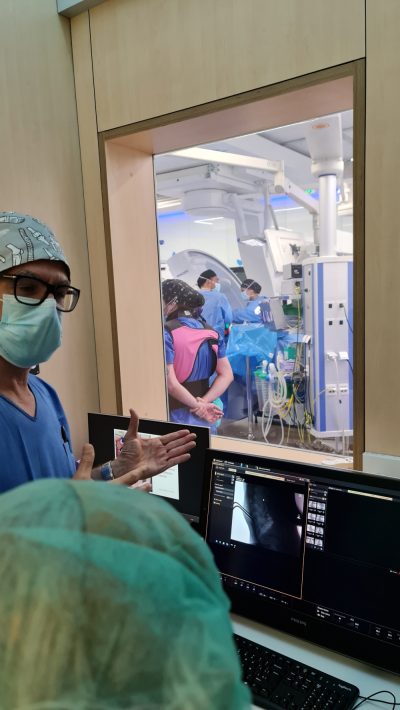
On the question of how much the pandemic had impacted SJD’s work, what were the most important lessons, he said that fortunately, the hospital was not hit very hard by the COVID pandemic because most of the children didn’t get ill. The children they treated who did have the virus were patients with underlying diseases that cause immunodepression. SJD’s role during the pandemic was to offer support to other hospitals for paediatric patients and even admit adult patients at the peak of the pandemic as well as offering a safer environment for pregnant women to give birth. It was very important to conduct early research on the impact of COVID on children and pregnancy (Kids Corona project, https://www.sjdhospitalbarcelona.org/en/kidscorona) and “share our experience and expertise we gained at the beginning with hospitals of countries that suffer the pandemic later than European countries, especially with Latin American children’s hospitals,” he adds.
Last month, SJD inaugurated the SJD Pediatric Cancer Center Barcelona, which is the first single-specialty hospital in paediatric oncology in Spain and the second in Europe. As Arias explained the centre was a dream that was born 15 years earlier but had to wait because of financial constraints. The new centre is a significant step in the specialization and development of paediatric oncology at the hospital. With this new facility they have greater capacity for treating patients through an innovative model that brings together medical treatment, research and compassionate care. “It positions us among the most specialised and expert child cancer centres in the world, like those in the USA and our colleagues in the Netherlands, the Princess Máxima Center.”
“Our biggest hope is to achieve the objectives that underlie the project: to cure 100% of cancer paediatric patients, to maximize the decrease in treatment sequelae, to improve the quality of life of patients that overcome the disease and to support the improvement of cancer treatment in childhood worldwide,” Arias concludes.
IBEC – Institute for Bioengineering of Catalonia
www.ibecbarcelona.eu
Biological robots swimming through the bloodstream isn’t science fiction anymore
Bojan Stojkovski
Biological robots that move through the bloodstream and distribute drugs to human cells and fight cancer aren’t science fiction anymore, thanks to researchers from the Bioengineering Institute of Catalonia (IBEC).
During the WPK’s study tour to Barcelona, a group of IBEC researchers, led by research professor and principal investigator of the “Smart Nano-Bio Devices” group at IBEC Samuel Sanchez, presented their findings and the innovative solutions that such so-called nanorobots can find for various health problems.

Thanks to 3D bioprinting and engineering, these nanorobots can swim through the bloodstream at unprecedented speeds and transport drugs in a targeted way into cancer cells, accumulating in specific locations and reducing side effects.
A million times smaller than a human hair, the nanobots are set to establish a milestone in nanomedicine and in the intelligent and personalised administration of drugs for the treatment of cancer, as Sanchez explained.
According to the Spanish scientist, there are many biological barriers that nanoparticles need to overcome in order to reach the tissue of the cancer tumour. IBEC researchers therefore needed to make something that could go faster and interact with the matrix, target the cells and be more efficient.
However, using these biological robots in a living organism and in patient cells is still in the initial phase. When it is fit for purpose it will enable customized, efficient therapies against diseases such as bladder cancer. Bladder cancer is currently the second most common malignant neoplasm of the urinary tract, with over half a million new cases and about 200,000 deaths per year. Due to its high recurrence rate and the lack of efficient diagnostic and therapy methods, bladder cancer is also one of the most expensive to treat in the world. This is where the nanobots come in and offer more efficient and economic solutions in the fight against this cancer.
During the WPK study trip, the scientists led by Sanchez also discussed the use of nanobots for future nanomedicine and environmental applications as well as breakthrough discoveries that have been observed in vivo: the collective movement of nanorobots, how the next generation of swimming living robots can self-train, and how tiny microbots can also clean up water.
Catalan Association of Scientific Communication, ACCC
https://www.accc.cat/
Get-together with Catalan science journalists
Astrid Viciano
A walk through summery Barcelona brought the EFSJ/WPK group from the IBEC research institute to Vil-la Urània, a beautiful old building with a café and event hall just around the corner.

On site, they met their colleagues from the Catalan Association for Scientific Communication, ACCC. First, the association’s president, Rubén Permuy, welcomed them with a short introduction, then science journalists Michele Catanzaro and Raül Toran presented two projects: PerCientEx, which works on the quality of science reporting, and illustrascience, which promotes the drawing of scientific illustrations, among other things in workshops, in order to convey scientific and medical knowledge to children and adults. EFSJ/WPK journalist Astrid Viciano also had the opportunity to present the EFSJ, the WPK and the project Medien-Doktor, the German health news review.
After the formal part of the evening, the colleagues met for a drink in the aforementioned café of Vil-la Urània to share their professional experiences. A most enjoyable and interesting meeting, which hopefully was only the beginning of an intensive exchange with the EFSJ and WPK.
PRBB – Barcelona Biomedical Research Park
www.prbb.org
Research where others go on holiday
Michael Lange
It is hard to imagine a more beautiful location for cutting-edge biomedical research. Barcelona´s city beach is only 100 metres away, and the old town of the metropolis less than a 10-minute walk. And so, it did not take long after the opening in 2006 to attract many renowned research organisations to the newly built PRBB research park. Now, 1,400 scientists work there. They produce an impressive 1,290 publications a year and receive about 120 million euros funding.
But all that is not enough to achieve academic flair in a modern high-rise building with laboratories of all kinds, according to Reimund Fickert. The German-born biologist is responsible for public relations at PRBB. When he started here, however, he had to tackle an internal problem. Everyone at PRBB at the time was doing research on their own, and many scientists didn’t even know who was working next door. Together with some colleagues, Reimund Fickert had to ensure the different groups communicated with one another. The team invited well-known guest speakers to Barcelona and organised scientific lectures and workshops. And – more importantly – Fickert initiated an extensive cultural and sports programme. This includes an orchestra, a choir, yoga classes and various sports activities; they have no fewer than 80 volleyball teams. All these groups now organise themselves and create a good sense of community.
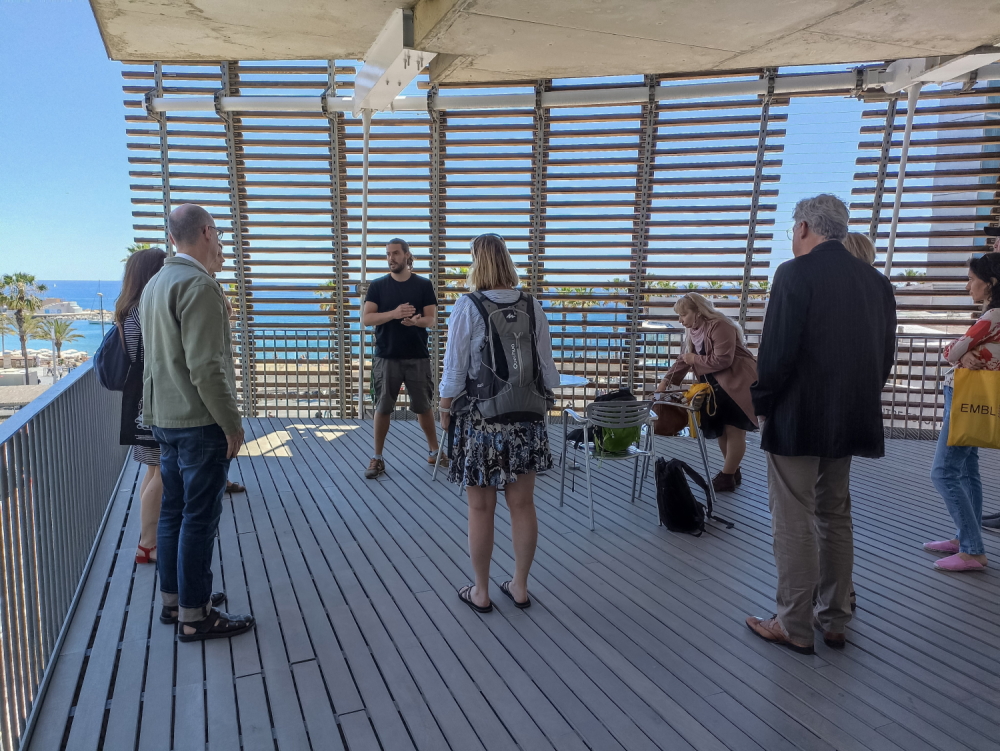
The most important thing, however, is still science. The labs support each other, and those who have specialised, expensive equipment also make it available to their neighbours when needed. Genome research plays an important role for several groups. Genome sequencing, for example, is used at CRG, the Centre for Genome Regulation. In the search for genetic sequences that are important for diabetes, the geneticists found what they were looking for in between the genes. They discovered crucial regulatory sequences in the areas that just a few years ago were still dismissively referred to as genetic junk. Now it is clear: the ‘junk’ plays an important role in regulating sugar metabolism and thus also in the development of diseases such as diabetes.
To observe how genes and cells cooperate in the lab, Diego Balboa grows insulin-producing beta cells in Jorge Ferrer´s CRG-laboratory. There the beta cells grow together with other cell types and build so called islets that resemble the natural islets of Langerhans in the pancreas. Balboa doesn´t have to go far to share ideas with other stem cell researchers. Maria Bernabeu also grows small organoids from stem cells in the same building. She is part of EMBL, the European Molecular Biology Laboratory, which only recently found its way to PRBB. She injects stem cells into a mould, and the cells form tiny vessels and develop into a small vascular system. This work allows her to study infection processes in detail, for example in malaria or Covid-19.
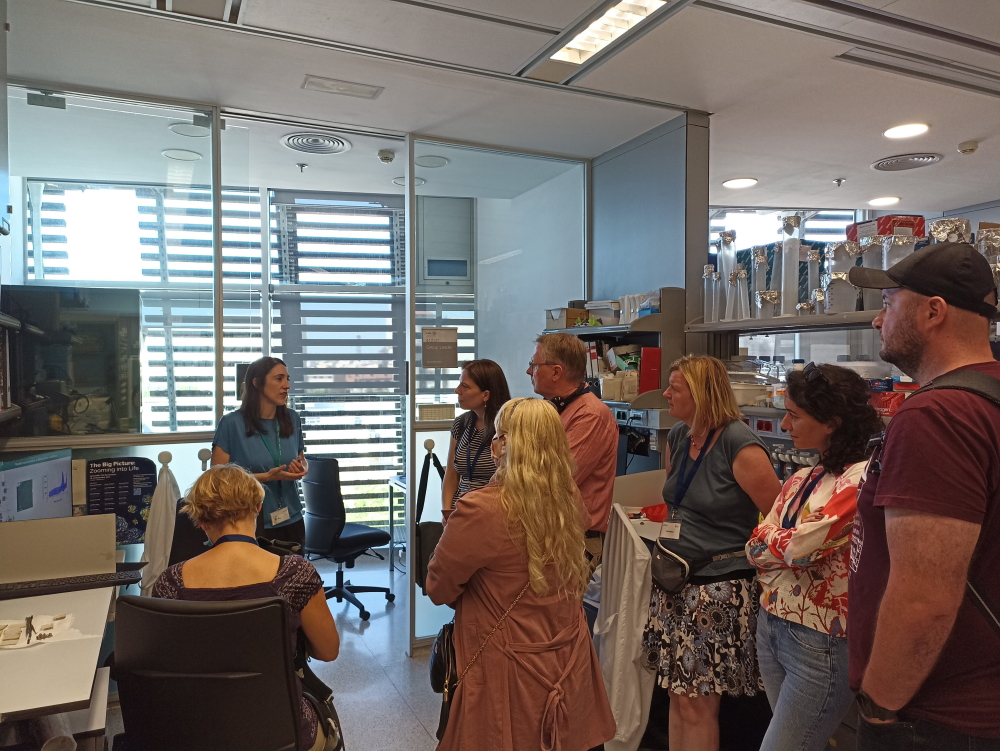
Other teams are working on brain models, the influence of environmental factors on health or therapies against Down´s syndrome. The list of projects carried out at PRBB would fill pages. But now the hot summer temperatures are dropping outside – the best time to relax on the beach nearby.
IDIBAPS – August Pi i Sunyer Biomedical Research Institute
www.idibaps.org
Therapies for the future – combating violence and breast cancer
Magnus Heier
- Virtual reality in the therapy of aggression
The idea is to use virtual reality to put people with a history of violence in the role of the victim. We try it out. In the videos we are shown we play the role of a woman facing an aggressive partner. Several different videos are shown – in every case a woman is the victim, a man the perpetrator. We watch the video through VR glasses. They record our own movements and convert head movements, for example, into movement in the video. The visual presentation is very simple – mine is also lengthy. It is difficult to put oneself in the situation (my own VR experiences in other contexts have been much more convincing technically). However, it should be possible to improve the presentation fairly quickly and easily.
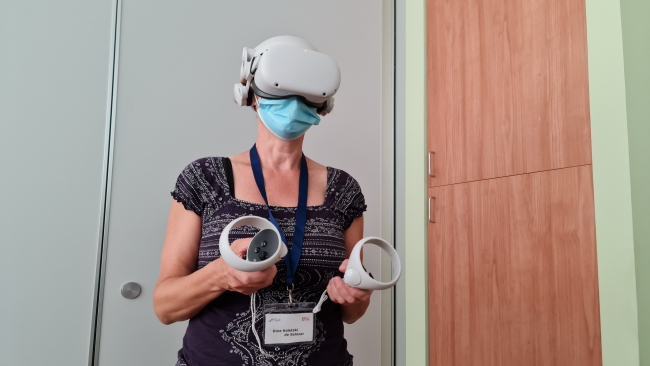
The theory behind this kind of violence therapy is that people who are prone to violence (or at least some of them) find it difficult or impossible to empathise emotionally with their victim. That they lack any empathy with their victims. That they learn to recognise and reduce these deficits through virtual reality. None of this is undisputed: only psychopaths actually lack emotion when it comes to violence.
We hear that this kind of VR sensitisation has been used with over 1,000 volunteers in Catalan prisons. The success has also been validated in questionnaires – whereby a sophisticated offender can fill out the corresponding questionnaire to meet the therapists‘ wishes. In addition, functional magnetic resonance imaging is used for control – but no one was able to tell us exactly what it reveals.
- HER2-positive breast cancer
Aleix Prat, Head of Oncology at Hospital Clinic Barcelona, presented his recent paper in the Lancet: „Development and validation of the new HER2DX assay for prediction pathological response and survival outcome in early-stage HER2-positive breast cancer“.
The manufacturing company Reveal Genomics is a spin off (in which Prat is at least partly involved; he didn’t want to be more specific): https://www.reveal-genomics.com/her2dx
[photo – IDIBAPS – tumour image]
The problem is that tumours are heterogeneous and their reaction to therapies varies. A prediction of which therapy in which combination, duration, concentration can be successful, whether a treatment must be intensified or can be reduced, would save lives. A wide variety of prognostic factors have been known for some time. The HER2DX assay described here combines 27 gene expressions with clinical factors and produces a long-term prognosis – and thus also a therapy recommendation. HER2DX is an algorithm-based tool.
Tissue samples of the breast tumour are examined. Costs of the examination and analysis currently: €2,900 per patient.
2022 Jan;75:103801, doi: 10.1016/j.ebiom.2021.103801. epub 2022 Jan 3.
ICTA-UAB – Institute of Environmental Science and Technology
https://www.uab.cat/icta/
Change of subject – change of location
Ina Helms
Today, we not only leave medicine and biomedical research behind, but also the vibrant life in the city of Barcelona right away.
Comfortably seated in a minibus, we drove about 20 kilometres inland, where we spent the morning at the Institute of Environmental Science and Technology (ICTA-UAB). Sustainability, environmental sciences and city gardening were on the agenda.
The first highlight was the six-storey building itself. It was completed in October 2014 and designed to meet the highest sustainability criteria: lowest possible water and energy consumption, appropriate building materials, such as a concrete structure with high thermal inertia.
On a guided tour we were told that the outer façade of the building includes a “bioclimatic skin”, a system which opens and closes automatically to regulate the storage of solar radiation and ventilation. The system responds to temperature, humidity, wind or sunlight in order to offer the best bioclimatic conditions inside the building at all times.
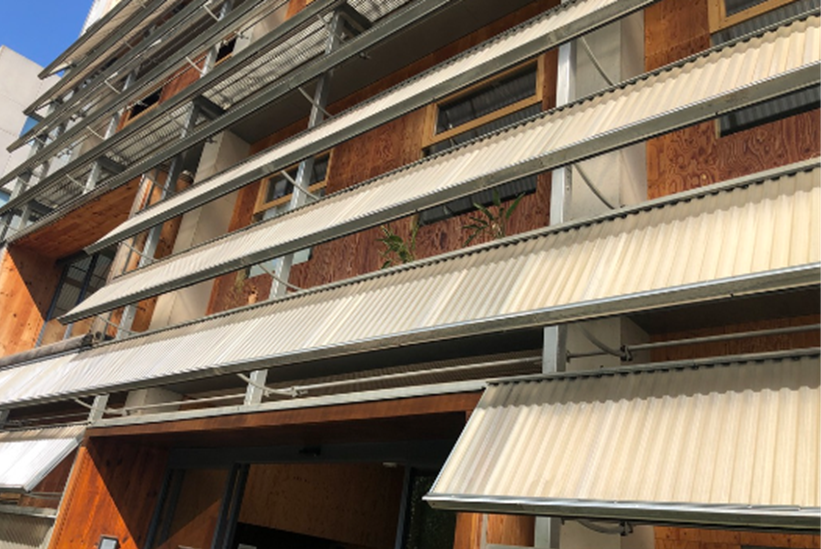
Offices and laboratories are spread over four floors. At the top, however, our hosts showed us their rooftop greenhouse which is connected to the building’s water, heat and CO2-flows. Xavier Gabarrell Durany, the director of ICTA-UAB, explained the benefit of rooftop greenhouses in terms of the following objectives:
- Reuse resources not consumed by the building => recovered heat-loss
- Collect CO2 produced by people and building activities for the benefit of plants
- Increasing food resilience in urban areas

The guided tour through the building and the subsequent lectures and discussions provided a good insight into the research that is done here. Our hosts describe it as “interaction between human and earth systems to build a sustainable future”. Their research program is structured around interrelated Societal Challenges, focusing on oceans, rural land, cities as well as production and consumption of goods and services. Half of the senior scientists, we were told, have ERC grants.
Following the lectures, we were able to learn more about some research projects on a lab tour. Patrizia Ziveris’ studies were fascinating, for example, as she talked very vividly about the pathways and the influence of microplastics on our ecosystem.
And so, an informative morning at ICTA-UAB ended with a lunch, to which we were invited in the pleasantly airconditioned main building.
Meeting, walk and dinner in Eixample with two representatives of the grassroots initiative Eixample respira https://www.eixamplerespira.com/
Alexandra von Ascheraden
Luca and … are active in the local community organization that aims to improve the quality of life in their part of Barcelona. They talked about noise and environmental problems in the residential areas caused by the high volume of traffic. Due to the multi-lane roads, the volume of traffic is so extreme that it is too dangerous to let children cycle to school. So, for example, they organise a „bike-bus“ in which the children cycle to school in a group under the guidance of adults. They also complained about a lack of consistency on the part of the municipality, for example, that although speed limits of 10 km/h are painted on side roads, they are never checked. Accordingly, motorists pay little attention to them. The activists try to communicate with the city administration in order to eliminate such weak points and achieve a better quality of life for pedestrians, cyclists and residents.
Office of the Chief Architect, Urban Ecology, Barcelona City Council
Reducing the traffic and greening the city
Alexandra von Ascheraden
The theme of our last day was green city and biodiversity. The lectures took place at the City Council of Barcelona. Dani Alsina, head of “superblocks”, and Izaskun Martí explained how the city is proceeding to partially free the wide thoroughfares from motor traffic and to create more green corridors and space for pedestrians and bicycles.
The city is trying to turn what are currently up to four-lane roads into one- or two-lane roads. This should give more space to non-motorised traffic and make it safer. Avenues with mixed tree populations are to be planted for quality of life and as links for biodiversity.
Parking space is not scarce in Barcelona, as many buildings have underground parking thanks to previous building regulations. Local transport in the city is well developed. The city districts are designed in such a way that schools, shops for daily needs and libraries can be reached on foot in fifteen minutes and residents do not have to rely on a car.
The main problem are the poor connections to the surrounding areas. This will continue to be the case for a long time, so that commuters will still have to rely on cars.
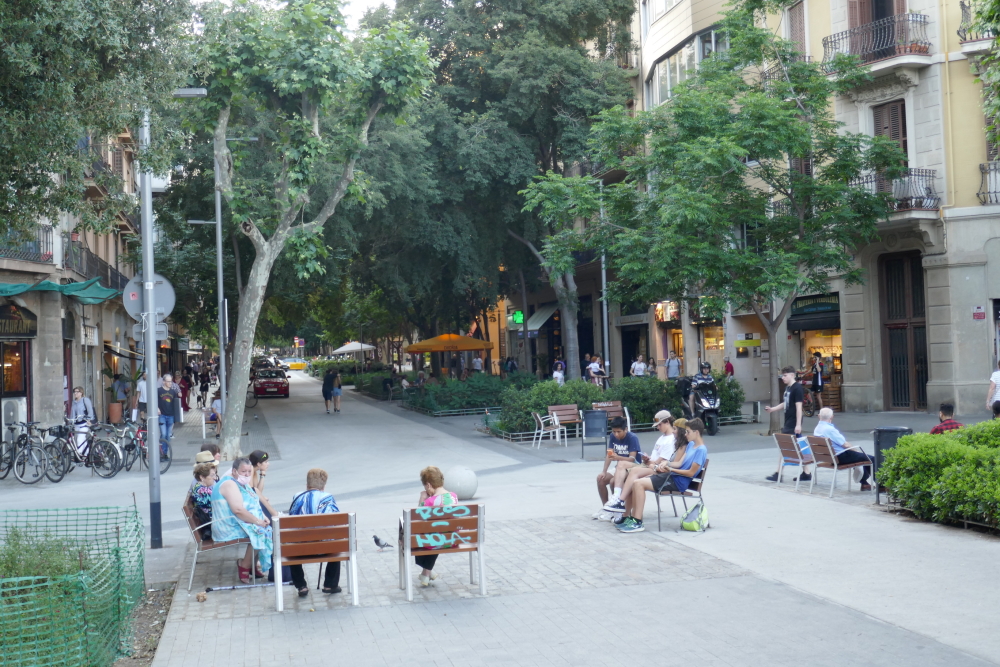
Another important urban development project are the superblocks. Barcelona is a planned city. All streets are located along planned squares. Piece by piece, some intersections are to be closed to motor traffic and given back to non-motorised traffic. Playgrounds and networking spaces are to be created for the neighbourhood population. This takes take a lot of time. At the beginning, the population felt that they were not being heard enough, but now the city is trying to find out more about the needs of those involved and to integrate the citizens better in the process of planning.
These newly created squares are first decorated with paint and street furniture as well as reversible planting. If they prove successful and a budget is found, permanent facilities such as playgrounds and parks will be built.
Finally, PR Officer Neda Kostadinovic gave us a tour of the neighbourhood. We saw the superblock Poblenou, which already has a playground and seating areas. She explained to us that the neighbourhood is a former industrial site. This has the advantage that it can be redesigned, and more space created. The city lays all the water pipes etc. right up to the property – and pays for them. Developers must in turn set aside a share of the building land for the general public. This is how the city can set up parks, community gardens or similar networking opportunities there. We were also shown the Gloriés Park that has been under construction for a couple of years because Barcelona is a very densely populated city but suffers from a lack green space. The park was made possible by the demolition of a bypass and the construction of tunnels. It is already well-used by the population and will also serve as a biodiversity axis.

WPK gratefully acknowledges the support of the Toepfer-Stiftung (Small Change for Europe programme), Hamburg, as well as the French, Italian and Swiss member associations of the European Federation for Science Journalism in realizing this field trip.
Photo credits: Alexandra von Ascheraden, Maria Bolevich, Ina Helms, PRBB, Bojan Stojkovski


